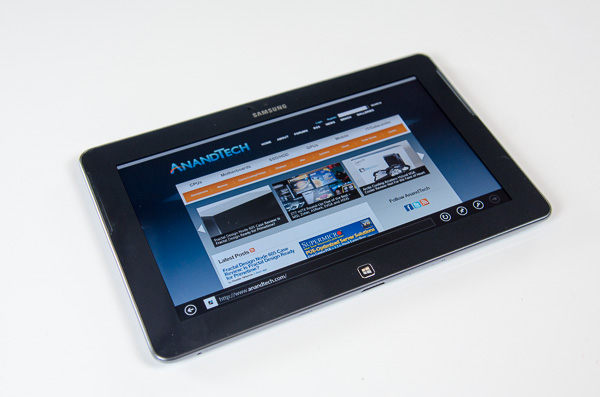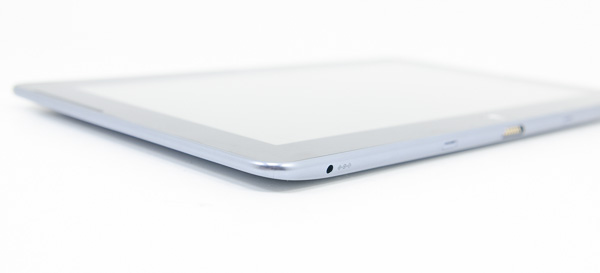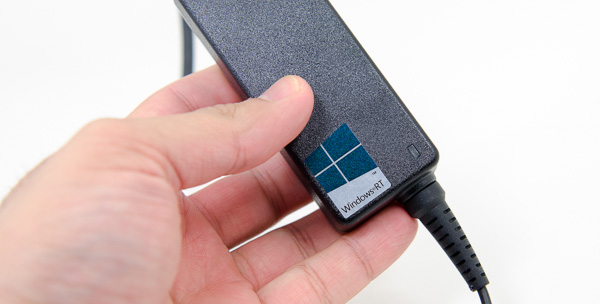Samsung ATIV Tab Review: Qualcomm's First Windows RT Tablet
by Anand Lal Shimpi on January 3, 2013 6:00 AM EST- Posted in
- Tablets
- Samsung
- Qualcomm
- Mobile
- Windows RT
Final Words
With better battery life than Surface RT and better performance as well, I have to say that in the ARM camp Qualcomm's APQ8060A is definitely the preferred SoC for Windows RT today. Qualcomm's single threaded performance advantage is obvious in interacting with the ATIV Tab, particularly for any work on the desktop (modern UI remains fairly smooth across all platforms). Application performance and web browsing performance are at worst equal to NVIDIA's Tegra 3, but at best are tangibly better. Intel continues to have the overall performance advantage (not to mention backwards compatibility), but at times Qualcomm remains surprisingly competitive in many of our tests.
Ultimately even Atom isn't quick enough to fulfill the dream of having a tablet that can really replace a modern notebook, and that's where the Windows RT/8 cookie crumbles for now. I suspect that once we get to the next generation of SoCs we'll see a better story from all of the vendors (22nm Atom, Cortex A15 based Wayne, Krait 200/300 from Qualcomm).
The ATIV Tab itself feels fairly well executed. Its performance is snappy (for Windows RT) and unlike my W510 experience, I didn't encounter much instability during my use of the Tab. Battery life is better than any other Windows RT or 8 tablet we've tested thus far. The Samsung/Qualcomm combination excels in video playback battery life in particular, giving us the first 10-inch tablet capable of lasting as long as a modern iPad in our video playback test. Web browsing battery life is also quite competitive, equaling the Clover Trail based Samsung ATIV Smart PC.
The 10.1-inch form factor and light weight construction make the ATIV Tab a device I wouldn't mind carrying around. Camera quality unfortunately isn't very good overall, particularly in low light situations. Thankfully, unlike most other Windows RT/8 devices we've tested thus far, the ATIV Tab does a great job when it comes to WiFi performance - equaling competitors from Apple and Google. Display quality is competitive with other Windows RT/8 tablets, but it does lag behind the iPad 3/4. If you absolutely need to buy a Windows RT tablet today and value performance more than design/build quality, the ATIV Tab isn't a bad option.
Although I like the ATIV Tab, I still feel like Windows RT/8 and the first generation of tablets need another iteration before they're truly ready for duty. I'd love to see the Surface team's industrial design paired with a faster SoC, a lighter chassis and a more cohesive OS. Windows RT/8 still feel rushed to me (for reasons I've explained before), let's hope that Windows Blue ships on time this year and delivers a more polished and complete experience.













42 Comments
View All Comments
Tech-Curious - Thursday, January 3, 2013 - link
Well said.Especially this bit.
MonkeyPaw - Thursday, January 3, 2013 - link
Actually, once you use a nice high-Res device, it is quite difficult to go back to a cheap panel. My vision is by no means great, but the difference between a TF300T and a TF700T is quite noticeable.More to the current weakness of Windows 8--they need to get auto-correct going. So far, the touch keyboard is just that. MS just seems behind on system-wide text entry advancements.
Tech-Curious - Thursday, January 3, 2013 - link
I'm not saying that a higher resolution can't improve your subjective experience on a very small screen -- but at the screen size we're discussing, the difference is nebulous, undefinable.(The high-res panel might also have better color fidelity or a better contrast ratio, for example. Resolution isn't the only determinant of image quality -- and by definition, resolution becomes less determinant as screen size dwindles.)
High resolution is a luxury, and as BrokenCrayons points out, it's a costly luxury. To me, the benefit of a larger resolution is more than offset by the performance penalty. A tablet with a high-res screen will tend to cost more, and it will tend to age faster than a lower-res analogue. After all, your TF700T has to draw 222% more pixels than your TF300T. (2.28 million versus 1.024 million.)
Do you really think the TF700T looks 222% better? If you'd never used the TF700T, would the display on the TF300T bother you at all? The inferior tablet in your example boasts a pixel density 10% higher than the pixel density of the perfectly serviceable desktop monitor on which I'm typing this post, BTW.
As usual, the matter boils down to a value proposition. Of course a higher-resolution screen is better than a lower-resolution screen, all else being equal, but people on any kind of budget should consider how well a given resolution fits into their budget, both now and in the future. I say the same thing about desktop rigs; if you're a gamer, for example, and you get yourself accustomed to ultra-high-res and/or multi-monitor gaming, then you are signing yourself up for a very expensive hobby. You may only have to buy the monitor(s) once, but you're gonna have to keep shelling out for high-end video cards to accommodate it (them).
On the other hand, someone who is accustomed to (and content with) lower-resolution gaming can wring an immense amount of value out of their computer hardware. Likewise, a consumer who's content with less-than-preposterous resolutions on a tablet will wring more value out of his tablets. He'll feel compelled to upgrade less often, which is probably the reason tablet manufacturers are pushing high-res screens so hard lately. ;)
Tech-Curious - Thursday, January 3, 2013 - link
(That should say, "your TF700T has to draw 122% more pixels than the TF300T." The former has 222% as many pixels as the latter, not 222% more pixels. :)Tech-Curious - Thursday, January 3, 2013 - link
All of that said, and whether you think a high-res tablet display is worth it or not, I think we can agree that killerclick's original, disparaging comment ("LOL @ 1366x768") was unwarranted given the size of the screen we're discussing.MonkeyPaw - Friday, January 4, 2013 - link
In my search to replace my Iconia A500, I tried a W510, TF300T, and the TF700T. I am normally a value shopper too, but the older I get, the more my definition of value changes. I used my last tablet every day, almost exclusively at home, and I don't play FPS games on a tablet. It's not IF the screen is some quantitative amount better, it is if the clearly better screen is worth the extra cost. Considering you also get faster internals and better build quality for an additional $70, I'd say it's worth it. I didn't find that much variation in battery life, and the TF700T lasts "all day" and charges in a couple hours. I used 5% of my battery in 40 minutes of web browsing this morning.Tech-Curious - Friday, January 4, 2013 - link
I'm glad you're happy with your purchase. To clarify, it was never my intention to criticize the TF700T as a bad value in total. I'm actually a bit of an ASUS fanboy.As you point out, there's more to the product than just the screen's resolution. My only point is that high resolution is a burden on the rest of the system. Like BrokenCrayons, I question how much practical use the consumer gets out of 1900x1200 on a 10.1" screen.
ninjacut - Thursday, January 3, 2013 - link
Its absolutely worth the price, considering it runs a full OS and not a Phone OS. If you compare the footprint, WP8 has same size has Android or iOS.Now add multi-user, desktop, office, file system, network share, with desktop grade utilities like power shell, explorer, task manager, disk manager, etc. etc. etc then obviously the footprint will be large.
Is that too difficult to realize?
mayankleoboy1 - Thursday, January 3, 2013 - link
Anand, both SunSpider and Kraken are outdated benchmarks. Browsers have optimisations for them, which doesnt translate into real world performance.The best benchmark is the "Google Octane". It consist of all real world tests.
DanNeely - Thursday, January 3, 2013 - link
Any idea when this will be finished? We've seen battery results a few weeks ago alongside the Acer 510 review; and you've added CPU/GPU numbers on it in this review. What's left to do before the writeup?